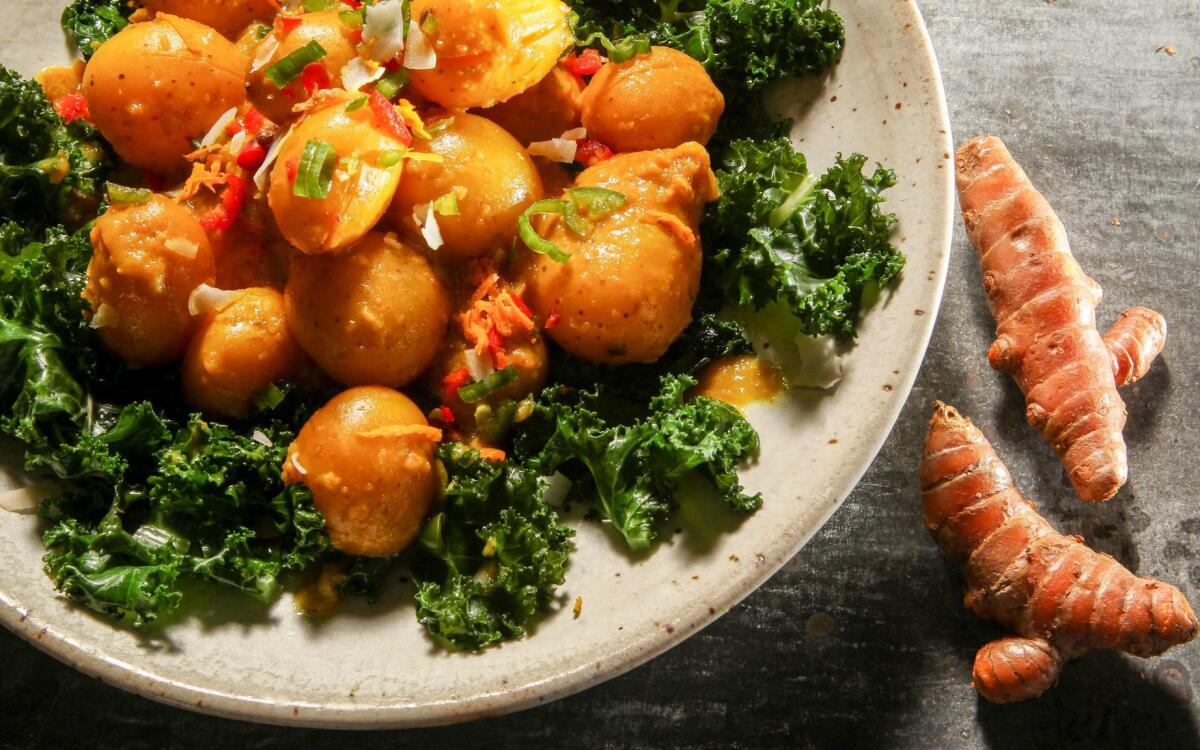Turmeric-braised baby potatoes with coconut kale

If you’ve ever eaten curry, and really who hasn’t, you’ve tasted turmeric. Turmeric is the spice that gives curry pastes and powders that vibrant golden hue. Long popular in India, the Middle East, Southeast Asia and North Africa, these days turmeric is having a golden moment. Maybe you’ve seen uber-fit yoga-moms sipping school-bus yellow juice. Or your dad takes turmeric supplements for his memory. And some of the cakes and muffins at your favorite hipster bakery may have turned strikingly yellow.
Turmeric is a rhizome, which means it has root-like stems that grow underground. It’s related to the ginger plant, and like ginger, turmeric can be eaten fresh or in powdered form. Powdered turmeric is available in most spice aisles, and these days fresh turmeric is routinely found in farmers markets and produce sections.
Powdered turmeric is ground from boiled and kiln-dried rhizomes. This process changes turmeric’s flavor from something akin to a complex gingery carrot to a bolder, slightly musty, peppery spice. While similar, dried turmeric and fresh turmeric have different cooking applications, not unlike that of fresh and ground ginger.
In Moroccan cuisine, turmeric is powdered. In a salad inspired by the North African country, carrots, chickpeas, red cabbage and a few grains of bulgur are tossed in lemony-turmeric vinaigrette. The colorful crunchy mix makes a light lunch or even a vegetarian dinner when topped with crumbled feta, but it’s also great with grilled fish or lamb. The chopped salad can be made ahead, but be sure to freshen it up with an additional squeeze of lemon, a drizzle of olive oil and a dash of turmeric before digging in.
Fresh turmeric imparts a delicate flavor and nearly florescent tinge to custards and creams. Try making silky-smooth, highlighter yellow panna cotta. The unexpected spice adds an exotic hue and flavor to this often rather bland Italian dessert. (You can also eat the grated turmeric that gets strained from the unset cream, as it will be sweet from the honey in the mix. This tasty bit of byproduct is basically candied turmeric.) Once set, top the gelled tangy cream with seasonal fruit — orange sections and pomegranate seeds in the winter, nectarines and plums in the summer.
Baby yellow potatoes get a chance to be the center attraction when slowly simmered in fresh turmeric-infused coconut milk. Creamy and redolent in this mild curry, golden peppers and cherry tomatoes further enhance the dish. Serve the saucy potatoes sprinkled with chopped chiles, grated turmeric and coconut chips on a nest of coconut-sauteed kale and you’ve got a hearty dish that will please vegetarians and omnivores alike.
There are other ways to add turmeric to your daily regimen. Add a one-inch chunk of fresh turmeric to your favorite smoothie —pineapple, romaine lettuce, orange juice and fresh turmeric make a particularly refreshing and bright blend. On cold days, steep grated fresh turmeric in your favorite milk until it’s saffron-colored, and sweeten the soothing, earthy potion with honey. When baking, grated turmeric adds gentle spice and bold color to pound cake and ginger scones.
Powdered turmeric adds verve to sautéing broccoli, green beans or cauliflower, especially when you add a healthy dose of garlic and squeeze of lemon. Or try mixing up your own ras el hanout. Literally translated from Arabic as “head of the shop,” the North African spice blend is flavored with turmeric and a muddle of other spices. Try stirring up some ground turmeric, mild red chili flakes, salt and black pepper to sprinkle over hummus, roasted vegetables and grilled meat.
A note of caution: Turmeric can stain your cutting boards, dish towels, aprons and fingers. The golden color will eventually fade from your fingertips, but the news is not so good for your washcloth. (Turmeric was once used to dye textiles such as monks’ robes, and it continues to be used as food coloring in margarine, cheese, mustards and pickles.)
So if you want to add more color to your life, you might start by cooking up these radiant recipes. Because turmeric, whether fresh or dried, sweet or savory, will put sunshine on your plate.
Using a small, sharp knife, cut a slit about halfway through each potato.
In a small Dutch oven or large, deep saucepan heated over medium-high heat, melt 2 tablespoons coconut oil. Add the onion and pepper and sauté until tender, about 8 minutes. Add the turmeric, ginger, garlic, cumin and red pepper flakes and stir until turmeric and ginger soften and the mixture is fragrant, about 4 minutes. Stir in the broth, coconut milk and tomatoes and simmer over medium heat, stirring occasionally until the mixture thickens slightly, tomatoes break down and is reduced to 6 cups, 15 to 20 minutes.
Stir in the potatoes and sprinkle over ½ teaspoon salt. Simmer the potatoes uncovered and over medium-low heat, stirring gently and occasionally until the potatoes are very tender yet still retain their shape, and the liquid has reduced to a thin gravy, about 1 hour. Season to taste, if desired, with additional salt and ground pepper.
Meanwhile, in a large heavy skillet or deep pot heated over medium-high heat, melt the remaining 2 tablespoons coconut oil. Add the kale and coconut and season with ¼ teaspoon salt, or to taste. Saute until the kale is tender and bright green, about 3 minutes. Divide the kale among shallow bowls. Spoon the potatoes and gravy over the kale. Garnish if desired with fresh cilantro, lemon or lime wedges, and chopped chiles. Serve immediately.
Get our Cooking newsletter.
Your roundup of inspiring recipes and kitchen tricks.
You may occasionally receive promotional content from the Los Angeles Times.















